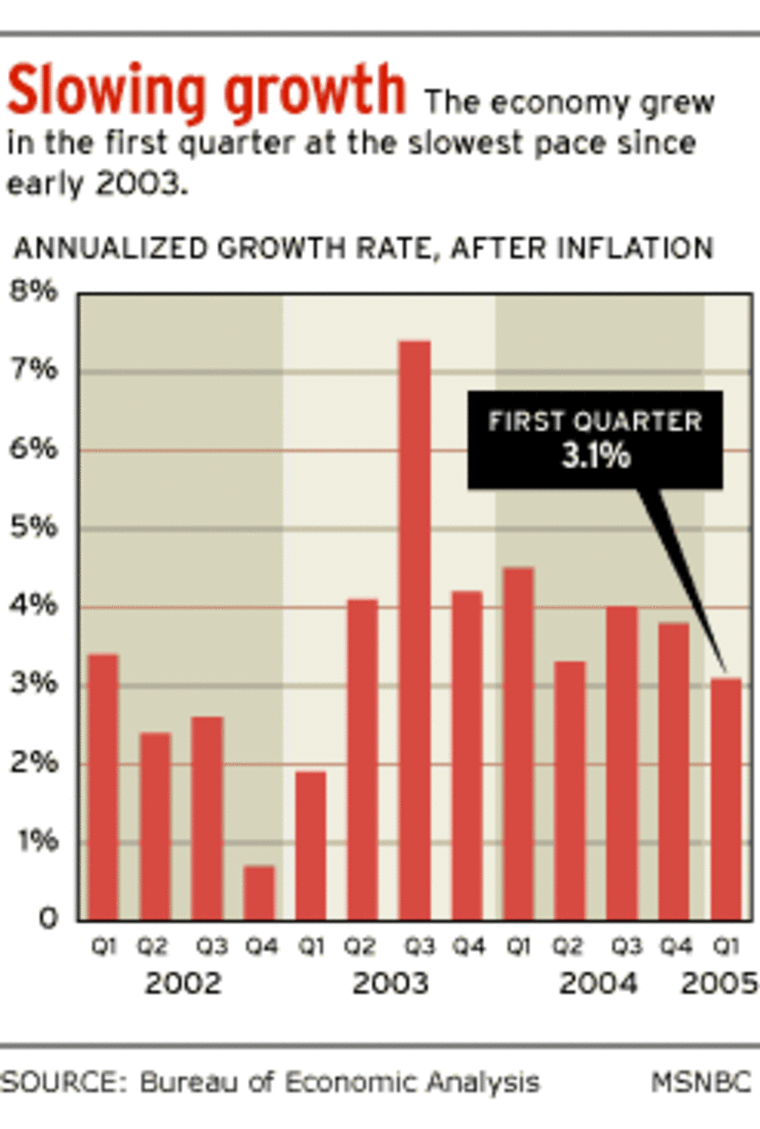Buffeted by rising energy prices and weakened consumer and business spending, the economy grew at an annual rate of just 3.1 percent in the first quarter. The slowest pace of expansion since in two years was evidence of a new “soft patch.”
The latest reading on gross domestic product, released by the Commerce Department Thursday, showed that consumers and businesses turned cautious in their spending, a key factor in the slower economic growth. High energy prices and rising borrowing costs are causing Americans to tighten their belts a bit.
The first-quarter GDP figure, down from a 3.8 percent pace logged in the final quarter of 2004, represents the economy’s most sluggish showing since the first quarter of 2003, when economic activity expanded at an even more mediocre 1.9 percent rate.
GDP, the broadest barometer of the economy’s health, measures the value of all goods and services produced within the United States.
On Wall Street, stocks slumped.
In second report Thursday, the number of new people signing up for unemployment benefits rose last week as businesses coped with rising costs. New claims rose by 21,000 to 320,000, the Labor Department said.

The newest snapshot of the economy disappointed economists. Before the report’s release, they were forecasting a 3.5 percent growth rate for the first quarter.
That estimate marked a downgrade from just a few weeks ago when economists were predicting that business growth would clock in at a pace of 4 percent or better in the first quarter. But they scrambled to lower those forecasts in the wake of a spate of disappointing economic reports in recent weeks.
Those disappointing reports — including retail sales, industrial production and big-ticket orders to factories — along with Thursday’s GDP figure, add to evidence that the economy hit a “soft patch.” That’s the term Federal Reserve Chairman Alan Greenspan used last spring when economic growth slowed abruptly.
Economists also are lowering their estimates for growth in the current April-to-June quarter — to around a 3 percent rate — or possibly less.
For now, economists believe any soft patch will be temporary and don’t believe that it would be a harbinger of recession. Although a 3.1 percent growth rate is disheartening to economists, it is a decent pace of expansion.
“That’s about average growth. You can’t say average growth is bad. Of course, every parent wants their children to be better than average,” said Ken Mayland, president of ClearView Economics. “It doesn’t mean that the game is lost and you are inevitably heading toward a major slowdown or recession.”
President Bush wants to see the economy on solid ground as he tries to sell Americans his vision of overhauling the Depression-era Social Security program. He is promoting the idea of letting workers set up individual investment accounts in stocks and bonds, using a big chunk of payroll taxes to do that.
The signs of slowing economic growth are especially disconcerting because they raise new questions about the state of the labor market, whose recovery from the 2001 recession has been uneven. Payrolls expanded by just 110,000 jobs in March, the lowest level in eight months. The employment report for April will be released by the government next week.
An inflation gauge tied to the GDP report and closely monitored by the Federal Reserve showed prices — excluding food and energy — rising at a rate of 2.2 percent in the first quarter of 2005. That was up considerably from a 1.7 percent rate in the fourth quarter and marked the highest reading since the final quarter of 2001.
To combat inflation, Federal Reserve policy-makers have boosted interest rates seven times since last June. An additional increase is expected at the Fed’s next meeting on Tuesday.
Economists blame rising prices for energy and other goods for dampening consumer and business spending.
Oil prices, which surged to an all-time high of $57.27 a barrel at the beginning of April, have retreated somewhat since then. Even so, economists are predicting lofty prices for gasoline and other energy products through the summer.